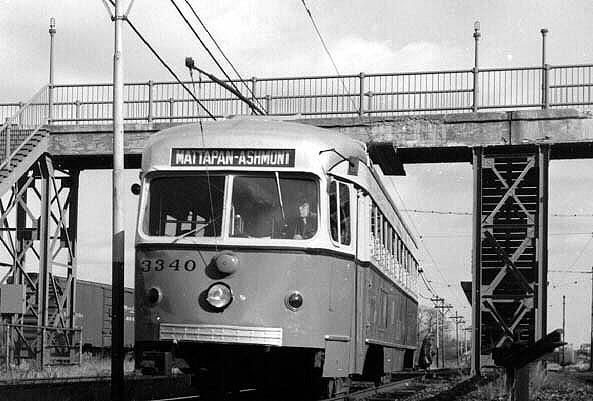
Matthew D. Cosgro in 2002
- Builder
- Pullman-Standard Car Co.
- Description
- PCC, Double-end air-electric
- Secondary Use
- None
- Type
- City and Suburban Streetcars
- Year
- 1945
- Retired from Service
- 1982
- Acquired by the Museum
- 1982
- Fund
- 590
Metropolitan Transit Authority 3340
From Boston, Massachusetts
History
The PCC car takes its name from the Electric Railway Presidents Conference Committee established in the early 1930s to design a modern, streamlined streetcar. It was a successful design with approximately 5000 PCC cars being built between 1936 and 1952 for systems in the U.S. and Canada. Some PCC cars built after World War II used the all-electric variation having electric brakes instead of the earlier air-operated brakes. Most older streetcars had been double ended, but most PCC cars were single ended. So, companies operating PCCs had to build loops or reversing wyes at the ends of lines. A few companies, of which Dallas Railway & Terminal was the largest, insisted on a double ended PCC configuration to avoid redesign of their tracks. In 1945, Pullman-Standard built 25 double ended PCCs for DR&T, Nos. 601-625. When Dallas ended streetcar service in 1956, these cars were stored.
After 1951, Boston’s Metropolitan Transit Authority had a large fleet of 321 single ended PCCs. However, the MTA still had nine old Type 5 cars running on two lines requiring double end operation. To replace these older cars, the MTA purchased eight of the Dallas double ended cars in 1958 and placed them in service in 1959. The MTA was pleased with these cars and needed additional capacity with the opening of the Riverside line. So, later in 1959, the MTA purchased the remaining 17 Dallas double ended cars, including No. 615, which the MTA renumbered as No. 3340. These cars went into service in Boston in 1960, primarily on the Ashmont – Mattapan line. The PCC cars continued under Massachusetts Bay Transportation Authority ownership beginning in 1964. When the MBTA adopted its color-coding scheme for its various transit lines in 1967, the MBTA repainted most of its PCC cars from their original orange and white to a green and white paint scheme. In 1976, the MBTA began replacing the PCC cars with LRV cars such as No. 3424 which is now at Seashore. Even after the LRVs became museum pieces, eleven PCC cars continue to run in regular service on the MBTA’s Ashmont – Mattapan line.
In 1982, Seashore acquired nine of the former Dallas PCCs from the MBTA. These were Nos.: 3326, 3327, 3328, 3331, 3332, 3338, 3340, 3343, and 3344. Seashore intended to resell all of these except for No. 3340. Seashore repainted No. 3340 in its Boston orange paint scheme and operated it for a time. In 1978, Seashore had also acquired ex-Dallas PCC car No. 3342 from the MBTA. Seashore restored that car to its appearance as Dallas No. 608. Seashore has acquired representatives of each type of Boston PCC: Pre-war style (No. 3019), wartime with a flat roof (No. 3127), wartime with raised roof (No. 3083), Post-war with standee windows (No. 3221), Post-war with picture windows (Nos. 3274 and 3292), and double-ended (No. 3340).
Technical Information
- Seats: 42
- Control: Westinghouse PCC
- Brakes: Dynamic / Air Drum / Track
- Compressor: PC-2
Trucks
- Number: 2
- Manufacturer: Clark
- Model: B-2
Motor
- Number: 4
- Manufacturer: Westinghouse
- Model: 1432HE
Weight and Dimensions
- Length: 47’ 0.00"
- Width: 8’ 4.00"
- Height: 11’ 1.00"
- Weight: 39360 lbs.
Additional Images

In Boston from Bill Volkmer collection in newdavesrailpix.com
© 1998 - 2025 New England Electric Railway Historical Society. All Rights Reserved.